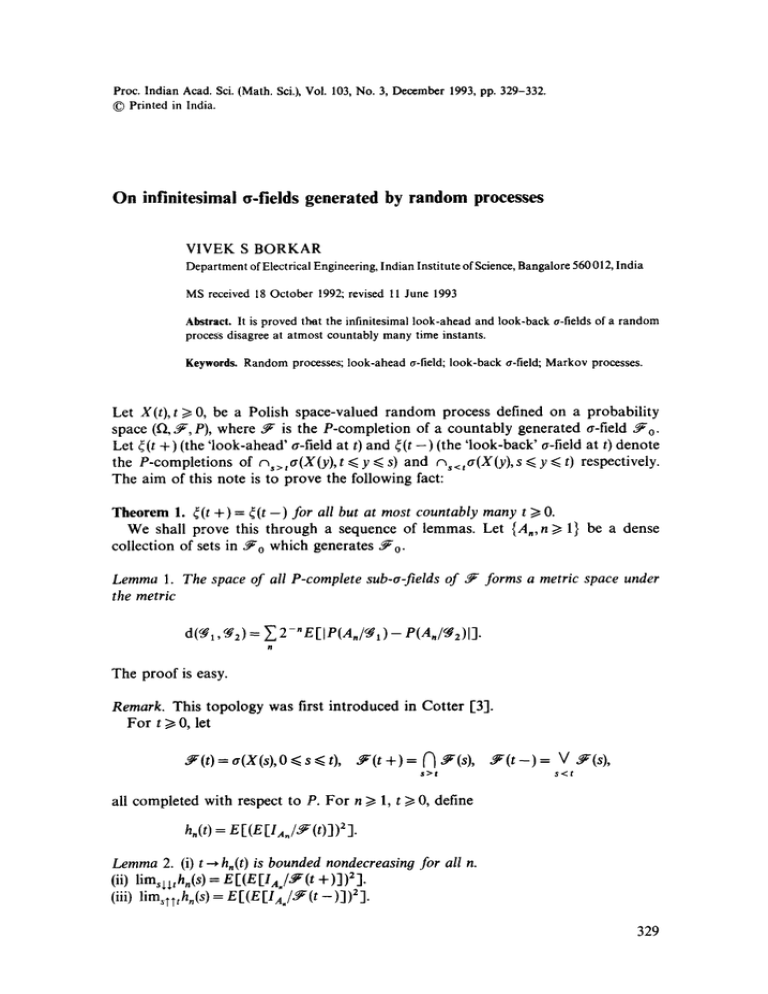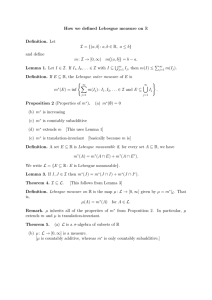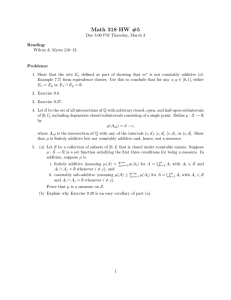Proc. Indian Acad. Sci. (Math. Sci.), Vol. 103,... 9 Printed in India.
advertisement

Proc. Indian Acad. Sci. (Math. Sci.), Vol. 103, No. 3, December 1993, pp. 329-332.
9 Printed in India.
On infinitesimal ~-fields generated by random processes
VIVEK S BORKAR
Department of Electrical Engineering, Indian Institute of Science, Bangalore 560 012, India
MS received 18 October 1992; revised 11 June 1993
Abstract. It is proved that the infinitesimal look-ahead and look-back o-fields of a random
process disagree at atmost countably many time instants.
Keywards. Random processes; look-ahead a-field; look-back a-field; Markov processes.
Let X(t),t >1O, be a Polish space-valued r a n d o m process defined on a probability
space (~, ~ , P), where ~ is the P-completion of a countably generated a-field ~ o .
Let ~(t + ) (the ' l o o k - a h e a d ' a-field at t) and r - ) (the ' l o o k - b a c k ' a-field at t) denote
the P-completions of c~>,a(X(y), t <~y <~s) and c~s<ta(X(y), s ~< y ~< t) respectively.
The aim of this note is to p r o v e the following fact:
Theorem 1. ~(t + ) = ~ ( t - ) for all but at most countably many t >, O.
We shall prove this through a sequence of lemmas. Let { A . , n ~ l} be a dense
collection of sets in ~-o which generates ~ o .
Lemma 1. The space of all P-complete sub-a-fields of ~ forms a metric space under
the metric
d(~x, ~2) = ~ 2-nE[JP(A./~,)
- P(A,/~2)[].
n
The p r o o f is easy.
Remark. This topology was first introduced in Cotter [3].
F o r t >/0, let
.~(t)=a(X(s),O<.s<.t),
#r(t+)=N#'(s),
s>t
# ' ( t - ) = V3r-(s),
$<t
all completed with respect to P. F o r n t> 1, t >1 0, define
hn(t) = E[ (E[I A,/:~ (t) ])2].
Lemma 2. (i) t ~ hn(t) is bounded nondecreasin# for all n.
(ii) lims~th,(s) = E [(E [I A / ~ (t +)])2 ].
(iii) lim eT~thn(s) = E [ (E [ I a . / ~ - ( t - )])2 ].
329
330
Vivek S Borkar
Proof. (i) follows from the conditional Jensen's inequality and (ii), (iii) follow from
the convergence theorems for regular martingales and reversed martingales [2]. []
From (i) above, it follows that each h.(') has at most a countable set of points of
discontinuity. Let D c [0, ~ ) be the at most countable set of points where one or
more of the h~(.)'s is discontinuous.
Lemma 3. For t ~ D , ~ ( t +) = ~ ( t - ) .
Proof. For tq~D, Lemma 2 (ii), (iii) imply that
E [ ( E [ l a . / ~ ( t +)-])2] = E [ ( E [ I A . / ~ ( t _ ) ] ) 2 ] ,
n .>- 1.
Thus
E[(E[laJ~(t
+ ) ] - E [ ( E [ I A . / ~ ( t _)])2.] = 0,
implying E [ I A . / ~ ( t + ) ] = E [ I A J ~ ( t - ) ]
Lemma 1.
n/> 1,
a.s., n>~l. The claim follows from
[]
COROLLARY 1
r
+) c ~(t - ) for all but at most countably many t.
Proof. Let {rm } be an enumeration of rationals in [0, co). Define ~-"(t), ~m(t +),
~ " ( t - ) , h~(t) as in (1)-(4) resp. with X(r~, + .) replacing X('), m/> 1. The foregoing
results hold for each X ( r m + .) as well. For every rational r/> 0, let
D, = {t > riP-completion of V a(Xs, r .<. s <~t - 5)
e>0
P-completion of (~ tr(Xs, r <~s <<.t + e)},
~>0
D = ~ D r.
Then by Lemma 3, D, and therefore/5 is at most countable. Fix tr
be a collection of rationals increasing to t. Then for i >i 1,
and let {rmt0}
V t r ( X , rm, ) ~ s <<. t - 5) = N a ( X , rm(0 ~ S ~ t + 5)
e>0
e>0
on P-completion. Thus
~ ( t + ) c P - c o m p l e t i o n of V tr(Xi, rr~ti}<<.s<~t-e),
i>>.i,
e>0
and hence
~(t +) c P-completion of ~. V a(Xs, rm, ~<~s <~t - 5) c r
i
e>O
-).
On infinitesimal a-fields generated by random processes
The claim follows.
331
[]
Proof of Theorem 1. It suffices to consider tel0, T] for some finite T > 0. Applying
the above corollary to the process X ( T - t), t s [0, T], we conclude that r (t - ) c ~ (t + )
except at most countably many t. Combine this with the corollary to conclude.
[]
COROLLARY 2
I f X (') is a Markov process, then ~(t +) = ~(t - ) = ~(t) ( a= the P-completion of a(X (t))),
at all but at most countably many t.
Proof. Note that ~ ( t ) c ~ ( t + ) n ~ ( t - )
for all t~>0. Let t~>0 be such that
~(t + ) = ~ ( t - ) . Since X(') is Markov, ~(t +), r
are conditionally independent
given X(t). Thus r
is conditionally independent of itself given X(t), implying
~(t + ) ~ r
Similarly r - ) c ~(t).
[]
It is conjectured that the conclusions of Corollary 2 hold even in absence of the
Markov property. If true, this result will have important implications in stochastic
control theory [1]. We conclude with an example to show that one cannot improve
on Theorem 1 in general.
Example Let ~ = [0, 1] ~, ~ 0 = the product Borel a-field, P = the product Lebesgue
measure and ~ the product a-field completed with respect to P. Let w = (w~, w 2, .-.)
denote a typical element o f ~ . Let {r,} be an enumeration of rationals in (0, 1). Define
an R~-valued process X(t) = I X 2(t), X2(t), .-.], t~[0, 11 as follows: [X l(t), X z(t),...]
evaluated at the sample point [wt, w 2, ...] is given by
X21(t ) = w2i[ (t -- ri) +],i >>.1,
X2i_l(t)=w2i_l[(t--ri)-'],
i~ l,
for t~[0, 11. Then it is easy to see that ~(t +), ~ ( t - ) , ~(t) are the P-completions of
r i G , + (t), FIG~-(t), FI G~ respectively, where G+, (t), G~ (t), G~ are as described
below: Let ~ = the Borel a-field of [0, 1], f l = the trivial a-field {tp, [0, 1]} on [0, 1].
Then for n/> 1,
GUt) = ~ if t/> r ,
G;._1(t) = ~B if t < r ,
= fl otherwise,
= fl otherwise,
= ~B if t > r , = fl otherwise,
G~._ i (t) = ~B if t ~<r , = fl otherwise,
G~
G~
= @ if t > r , = fl otherwise,
(tl = ~ if t < r , = fl otherwise.
It follows that ~(t + ) = ~(t - ) = ~(t) for t irrational in [0, 1] whereas ~(t + ) :~ ~(t - ) r
~(t) for t~{r,,n >~ 1}.
332
Vivek S Borkar
R e m a r k : One may replace X(.) above by a real valued process without altering the
conclusions by virtue of the isomorphism theorem for Polish spaces (Theorem 2.12,
p. 14, of [4]).
Acknowledgements
This work is supported by grant No. 26/01/92-G from the Department of Atomic
Energy, Government of India.
References
[1] B•rkar V S• •n extrema• s••uti•ns t• st••hasti• ••ntr•• pr•b•ems II. App•. Math. •ptim. 28 ( • 993) 49-56
[2] ChowY S and TeicherH, Probability theory - independence, interehangeability, martingales (New York:
Springer Verlag) (1978)
[3] Cotter K D, Similarityof informationand behaviourwith a pointwiseconvergencetopology,J. Math.
Econ. 15 (1986) 25-38
[4] Parthasarathy K R, Probability measures on metric spaces (New York: Academic Press) (1967)






